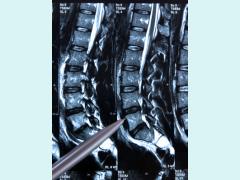
Spinal disc herniation
A spinal disc herniation, incorrectly called a "slipped disc", is a medical condition affecting the spine, in which a tear in the outer, fibrous ring of an intervertebral disc allows the soft, central portion (nucleus pulposus) to bulge out. Tears are almost always posterior-ipsilateral in nature due to the presence of the posterior longitudinal ligament in the spinal canal. This tear in the disc ring may result in the release of inflammatory chemical mediators which may directly cause severe pain, even in the absence of nerve root compression (see "chemical radiculitis" below). This is the rationale for the use of anti-inflammatory treatments for pain associated with disc herniation, protrusion, bulge, or disc tear.
It is normally a further development of a previously existing disc protrusion, a condition in which the outermost layers of the annulus fibrosus are still intact, but can bulge when the disc is under pressure. Spinal disc herniation is very common ailment. It is estimated that, in varying degrees up to 30% of people in the age group 30 - 50 years suffers it. In patients of age 60+ the degenerative changes of discs are considered to accompany the process of normal aging.
Most problems are caused the spinal disc herniation - more than 90% qualifies for a non-surgical treatment. In some patients, symptoms caused by spinal disc herniation disappear spontaneously, but the majority of patients in this group have further incidents, usually requiring a longer treatment. In the first place the conservative treatment is proposed for those patients who had no interruption in the continuity of the annulus fibrosus, regardless of the degree of damage. In conservative treatment, the large role is played by the methods of physiotherapy.